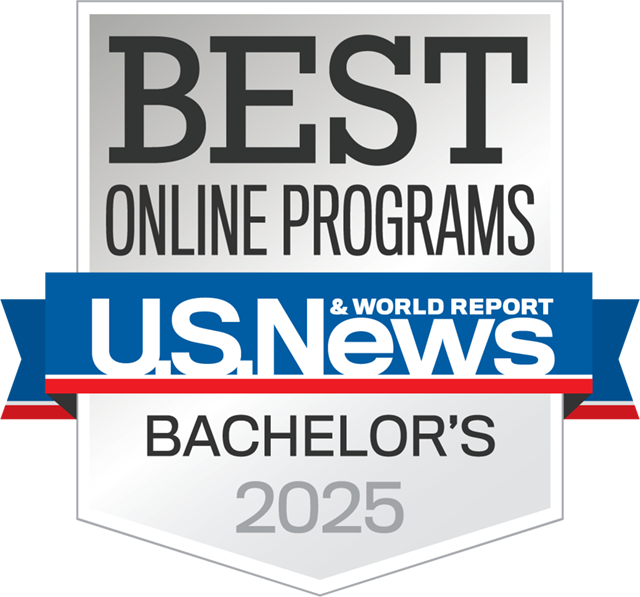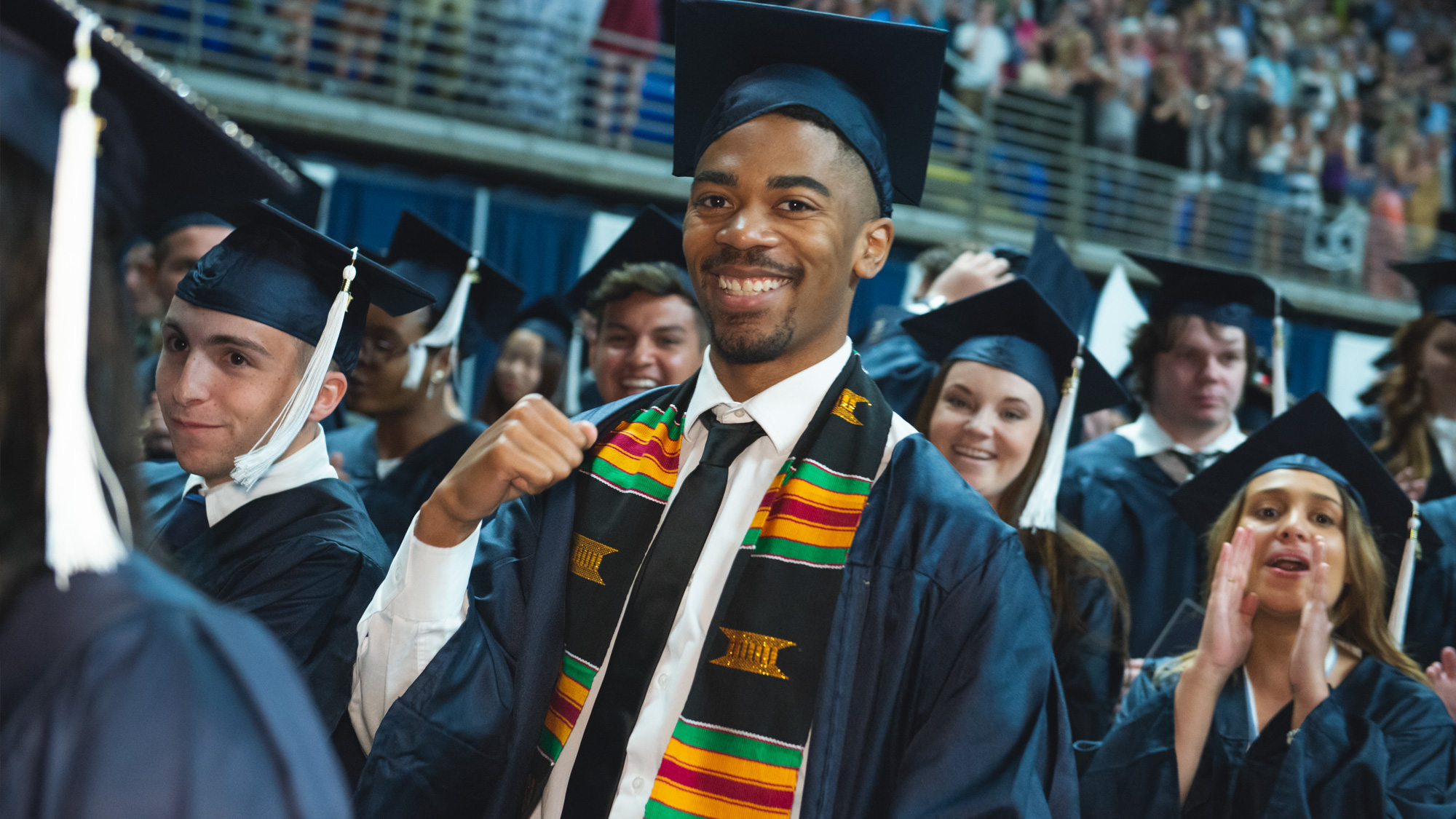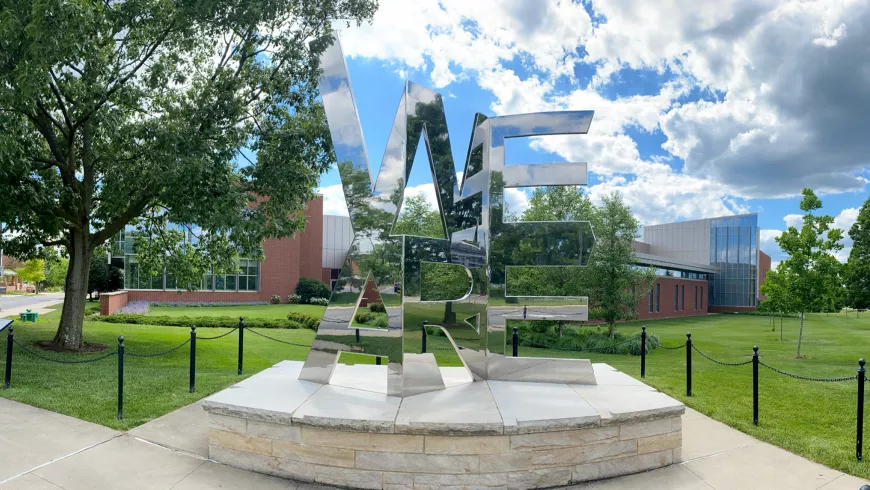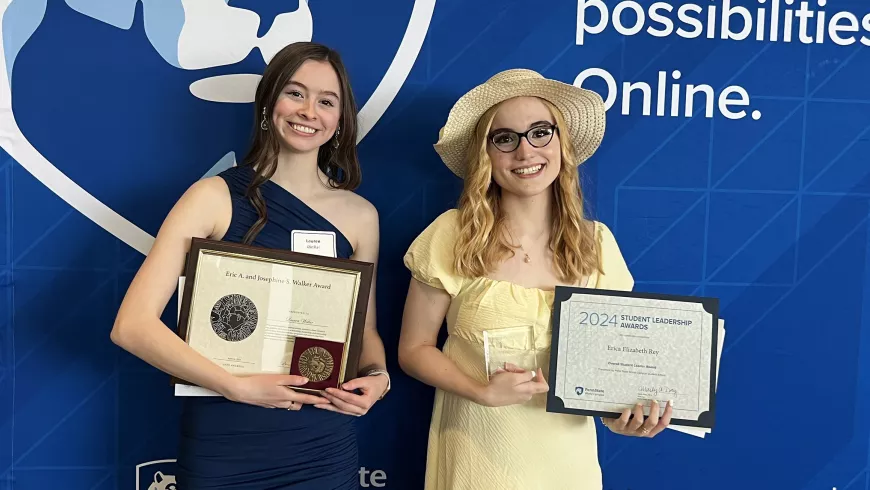100% Online
Complete your Penn State course work at your own pace and 100% online.
Application deadline
Credits and costs
Nationally Recognized

Become a Design Leader in the Creative Industries with a Multimedia Degree
Develop and apply sound design practices to computational projects in a variety of digital media through testing and prototyping.
Produce compelling visual design and apply it to code-based animations, interactive applications, and games.
Adapt the design process to solve contemporary, real-world design issues.
Discover, define, develop, and deliver effective design using information technology principles and communication skills.
Online Digital Multimedia Design Degree Courses
Online Digital Multimedia Design Degree Courses
This program integrates courses in visual arts and design, information sciences and technology, communications, and General Education electives.
Through your course work, you can enhance your ability to use creative thinking and critical reasoning to organize ideas and present them in a range of visual forms, scenarios, and narrative projects. You'll also have the opportunity to study in a collaborative format that will allow you to work with other students to further explore and apply what you're learning.
The Bachelor of Design in Digital Multimedia Design program requires you to complete a minimum of 120 credits.
Students can earn up to 6 COMM credits through the credit-by-portfolio process. However, it is important for students to know that completing the credit-by-portfolio process does not guarantee that the credits will be awarded.
Prescribed Courses (27 credits)
- 3credits
An introduction to the language, aesthetics, and cultural impacts of digital art and design in contemporary society.
- C or better
A student enrolled in this course must receive a grade of C or better.
- 3credits
An introduction to digital photography, emphasizing camera skills, aesthetics, and storytelling.
- Note
Basic Photography for Communications is a hands-on, skills-oriented, results-driven class that requires students to own a suitable mobile phone along with a computer and software. Please contact Will Yurman, instructor, at [email protected] with any questions or concerns.
- C or better
A student enrolled in this course must receive a grade of C or better.
- 3credits
The application of creativity to the practical concerns of narrative script and radio/television spot writing.
- Prerequisite
Enforced Prerequisite at Enrollment: ENGL 15 and ENGL 202
- C or better
A student enrolled in this course must receive a grade of C or better.
- 3credits
Introduces 2D digital imaging techniques and concepts for the production of original art and design using graphics software.
- C or better
A student enrolled in this course must receive a grade of C or better.
- 3credits
This course introduces students to concepts, skills, language and principles of practice in art and design, communication, and information sciences.
- C or better
A student enrolled in this course must receive a grade of C or better.
- 3credits
In this course students synthesize concepts, theories, and applications acquired in introductory courses and think critically about their professional objectives.
- Prerequisite
DMD 100 and 9 credits from the following list: IST 140, IST 250, COMM 230W, COMM 215, DART 202, ART 211Y
- C or better
A student enrolled in this course must receive a grade of C or better.
- 3credits
In this capstone, students develop portfolio projects by applying creative production concepts, tools, and approaches to a contemporary issue.
- Prerequisite
DMD 100 and DMD 300
- C or better
A student enrolled in this course must receive a grade of C or better.
- 3credits
Examines the relationship between physical capabilities, cognitive and social models, and philosophical issues pertinent to human-centered analysis, design and development work.
- C or better
A student enrolled in this course must receive a grade of C or better.
- 3credits
Introduction to how the World Wide Web utilizes emerging technologies. Students acquire a conceptual understanding of constructing websites.
- C or better
A student enrolled in this course must receive a grade of C or better.
Additional Courses (select 30 credits)
- 3credits
Introduction to visual studies; pictorial space and the principles of visual organization.
- 3credits
Introductory experience in making of art through drawing media; designed for nonmajors seeking general overview of studio practice.
- 3credits
Examination of individuals' selection, uses and perceptions of media and the effects of media on individuals' attitudes, beliefs, and behaviors.
- 3credits
The development of electronic media and telecommunications, emphasizing social, economic, political and global impact.
- 3credits
Students will evaluate content creation and distribution methods and demonstrate proficiency across emerging digital products and services.
- 3credits
Introduction to various modalities of idea development and written expression for media production.
- Prerequisite
Enforced Prerequisite at Enrollment: COMM 242 or COMM 282
- 3credits
Provides an overview of the various media and communications methods that comprise modern integrated marketing campaigns.
- 3credits
Development of an informed and critical approach to photocommunication; individual and team projects, seminars, and critiques.
- Prerequisite
Enforced Prerequisite at Enrollment: COMM 269
- 3credits
Development in the law, policy, and business of Internet-mediated communications and commerce; emphasis on impact on existing legal, regulatory, and economic models.
- Prerequisite
ENGR 310 or COMM 180 or COMM 271 or MGMT 215
- 3credits
Introduces 3D foundational skills for producing images, videos, objects, and interactive real-time virtual spaces with 3D software.
- 3credits
Introduces time-based animation fundamentals along with core skills and knowledge necessary for producing animated work.
- 3credits
Introduces essential techniques and concepts of modern web design, focusing on how visual graphics and layout contribute to user experience.
- 3credits
An intermediate level studio course in which students develop digital art and design work that promotes creative thinking and problem-based learning in producing digital media projects to be included in their digital portfolio.
- Prerequisite
DART 202 or DART 203 or DART 204 or DART 205 or DART 206
- 3credits
This course emphasizes the development of presentation skills for digital artists in audience/client interactions.
- Prerequisite
DART 300
- 3credits
Study foundational concepts and methodologies in User Experience (UX) design and thinking. The course will feature iterative design processes to employ basic management techniques in working with product stakeholders for digital planning practices.
- 3credits
Apply knowledge in User Interface (UI) design and practice designing and prototyping compelling visual interfaces for multiple platforms - from websites to physical spaces to the nuanced interactions in mobile and wearable environments.
- Prerequisite
GD 110
- 3credits
Introduction to object-oriented applications, including applications in an Object-Oriented Design (OOD) language or OOD languages.
- Prerequisite
A grade of C or better in IST 242 or CMPSC 221
- 3credits
This course addresses activities in the system development process that ensure usability. It considers the emerging concept of usability, requirements gathering and analysis, activity design, information design, interaction design, documentation design, user testing, and usability evaluation.
- Prerequisite
A grade of C or better in HCDD 331
- 3credits
Intermediate application development including algorithms, data structures, and object-oriented concepts.
- Prerequisite
A grade of C or better in IST 140 or CMPSC 121 or IST 240
- 3credits
Introductory design and development studio course for IST and SRA students.
- Prerequisite
A grade of C or better in IST 242 or permission of program
Supporting Courses (select 18 credits)
Choose 6 credits of history of art, design, technology, and communications courses in consultation with an adviser.
Choose 12 credits in related areas in consultation with an adviser.
General Education Requirements
Some General Education requirements may be satisfied by courses required for the major. Students should work with an adviser to select courses.
- Foundations: 15 credits
All courses require a grade of C or better. Inter-Domain courses may not be used for foundations requirements.- Writing/Speaking: 9 credits
- Quantification: 6 credits
3-6 credits are selected from mathematics, applied mathematics, and statistics; 3 credits may be selected from computer science or symbolic logic.
- Knowledge Domains: 15 credits
Inter-Domain courses may not be used for knowledge domain requirements.- Health and Wellness (GHW): 3 credits
- Natural Sciences (GN): 3 credits
- Arts (GA): 3 credits
- Humanities (GH): 3 credits
- Social and Behavioral Sciences (GS): 3 credits
- Integrative Studies: 6 credits
- Inter-Domain course work: 6 credits
- Exploration: 9 credits
- Natural Sciences (GN) (may be Inter-Domain): 3 credits
- GA, GH, GN, GS, and Inter-Domain courses: 6 credits
May include 3 credits of World Language course work beyond the requirements of the student’s degree program or at the 12th credit level, whichever is higher.
These General Education Requirements are for students who started in summer 2023 or later. Students who started earlier can review the prior version of the general education requirements.
Course Availability
If you're ready to see when your courses will be offered, visit our public LionPATH course search (opens in new window) to start planning ahead.
Start or Advance Your Career

Start or Advance Your Career
There is a need for multi-domain design thinkers and makers able to meet the challenges of today's complex world. The Bachelor of Design in Digital Multimedia Design can help you prepare for a career in a variety of creative industries, including technology, media, product design, and marketing.
Job Titles Related to This Degree
As a graduate of the program, you can use your skills to create, execute, and evaluate communication strategies — making you a valuable asset for businesses, corporations, government, and nonprofit organizations. The following roles are often held by people with this type of degree:
- Creative Director
- Design Director
- Digital Media Designer
- Graphic Artist
- User Experience (UX) Designer
- Web Designer
Employment Outlook for Occupational Fields Related to This Degree
Estimates of employment growth and total employment are provided by the U.S. Bureau of Labor Statistics and are subject to change. While these occupations are often pursued by graduates with this degree, individual outcomes may vary depending on a variety of factors. Penn State World Campus cannot guarantee employment in a given occupation.
Web and Digital Interface Designers
Graphic Designers
Art Directors
Special Effects Artists and Animators
Career Services to Set You Up for Success

From the day you're accepted as a student, you can access resources and tools provided by Penn State World Campus Career Services to further your career. These resources are beneficial whether you're searching for a job or advancing in an established career.
- Opportunities to connect with employers
- Career counselor/coach support
- Occupation and salary information
- Internships
- Graduate school resources
Upcoming Events
Ready to Learn More?
Get the resources you need to make informed decisions about your education. Request information on this program and other programs of interest by completing this form.
Ready to take the next step toward your Penn State bachelor's degree?
Costs and Financial Aid
Costs and Financial Aid
Learn about this program's tuition, fees, scholarship opportunities, grants, payment options, and military benefits.
Costs and Financial Aid
Undergraduate Tuition
Undergraduate tuition is calculated based on the number of credits for which you register and the number of total credits you have accrued at or transferred to Penn State.
Tuition is due shortly after each semester begins and rates are assessed every semester of enrollment.
2025–26 Academic Year Rates
| How many credits do you plan to take per semester? | If you have 59 or fewer credits | If you have 60 or more credits |
|---|---|---|
| 11 or fewer | $638 per credit | $685 per credit |
| 12–19 | $7,755 per semester | $8,371 per semester |
Undergraduate students taking more than 19 credits will be charged the flat tuition rate plus the regular per credit hour rate for each credit above 19.
Financial Aid and Military Benefits
Some students may qualify for financial aid. Take the time to research financial aid, scholarships, and payment options as you prepare to apply. Federal financial aid may only be used to pay for credits used to satisfy program requirements.
Military service members, veterans, and their spouses or dependents should explore these potential military education benefits and financial aid opportunities, as well.
Additional Cost of Attendance Details
To view the detailed list of cost of attendance elements:
- visit the Tuition Information site
- click the plus sign to expand the table
- select a semester from the World Campus row
Technical Requirements
Laptop Requirements and Recommendations
The following laptop specifications are recommended for first year students and required for second year students:
General Minimum Requirements
- CPU: Intel 2.3GHz Core i7 (10th Gen) or higher; Apple M-series
- RAM: 16GB
- GPU: NVIDIA or AMD, 4GB VRAM
- Storage: 512MB SSD
- HD Camera
Apple (recommended)
- MacBook Pro 14 or 16 (M-series) w/minimum 16GB RAM
Dell (recommended)
- Dell Precision 5570 Mobile Workstation w/Intel® Core™ i9
- 32 GB, 2 x 16 GB, DDR5, 4800 MHz memory
Graphic/Drawing Display Tablet (recommended)
- Used for Digital Arts and Animation
- Small to medium sized devices by Wacom, Huion, Xp Pen, Monoprice, iPad Pro, etc.
Design Your Path
Over the duration of your studies, you will have the opportunity to develop a robust portfolio of design work as well as create a self-directed project in the capstone semester. Along the way, you can customize your experiences through the program pathways — suggested curricula in functional multimedia topics. Visit the DMD Program Hub to view a dynamic representation of possible pathways and innovative web design.
Connect, Create, and Collaborate with Other DMD Students
The Digital Multimedia Design (DMD) Club at Penn State World Campus aims to foster a student community for the DMD program and provide members with the opportunity to interact with professionals, alumni, and other students with similar interests and goals. In addition, the club strives to provide insight into current research practices and career options within the digital media and design fields.
Set Your Own Pace

Set Your Own Pace
Whether you are looking to finish your program as quickly as possible or balance your studies with your busy life, Penn State World Campus can help you achieve your education goals. Many students take one or two courses per semester.
Our online courses typically follow a 12- to 15-week semester cycle, and there are three semesters per year (spring, summer, and fall). If you plan to take a heavy course load, you should expect your course work to be your primary focus and discuss your schedule with your academic adviser.
To Finish Your Degree in Two to Three Years
- Take 6 courses each semester
To Finish Your Degree in Three to Four Years
- Take 4–5 courses each semester
To Finish Your Degree in Five or More Years
- Take 2–3 courses each semester
Timelines may vary for students transferring credits from another school or based on course availability.
Convenient Online Format
This program's convenient online format gives you the flexibility you need to study around your busy schedule. You can skip the lengthy commute without sacrificing the quality of your education and prepare yourself for more rewarding career opportunities without leaving your home.
A Trusted Leader in Online Education

Penn State has a history of more than 100 years of distance education, and World Campus has been a leader in online learning for more than two decades. Our online learning environment offers the same quality education that our students experience on campus.
How to Apply to Penn State

How to Apply to Penn State
Apply by October 31 to start January 12
Application Instructions
Deadlines and Important Dates
Complete your application and submit all required materials by the appropriate deadline. Your deadline will depend on the semester you plan to start your courses.
Spring Deadline
Apply by October 31 to start January 12Summer Deadline
Apply by March 15 to start May 18Fall Deadline
Apply by June 30, 2026, to start August 24, 2026
Steps to Apply
To apply for this program, you must be a high school graduate, or have completed your GED.
You will need the following items to complete your application:
High school transcripts or GED transcript — First-year applicants are required to submit Self-Reported Academic Records (SRAR) when applying. Official high school transcripts for first-year applicants will only be required at the time a student accepts an offer of admission to Penn State.
Transfer international students will need to submit their high school transcript before their application can be reviewed.
Official college or university transcripts and/or official military transcripts (if applicable) — All college or university transcripts are required regardless of the length of time that has passed, the grades earned, or the accreditation of the institutions attended. Acceptance of transfer credit toward your degree is subject to final approval by the academic department. For detailed information, see the Transfer Students page.
Transcripts not in English must be accompanied by a certified translation.
English Proficiency — The language of instruction at Penn State is English. With some exceptions, international applicants must take and submit scores for the Test of English as a Foreign Language (TOEFL) or International English Language Testing System (IELTS). Minimum test scores and exceptions are found in the English Language Proficiency section on the Undergraduate Admissions International Requirements page. Visit the TOEFL website for testing information. Penn State's institutional code is 2660.
To begin the online application, you will need a Penn State account.
Create a New Penn State Account
If you have any problems during this process, contact an admissions counselor at [email protected].
Please note: Former Penn State students may not need to complete the admissions application or create a new Penn State account. Please visit our Returning Students page for instructions.
Accessing MyPennState
The MyPennState Portal provides access to our online admissions services. Before accessing MyPennState, you must have a Penn State account that will be used to access all Penn State systems. After creating an account, you will receive a unique Penn State User ID. You will need to enter your User ID followed by @psu.edu when signing in to MyPennState and other Penn State sites. For example, you should be entering something like '[email protected]' in the Sign In field.
The application consists of six sections:
- Application Setup
- Program of Study
- Citizenship and Residency
- Academics and Experience
- Miscellaneous
- Review and Submit
Application Setup
Be sure to select "Online" for the "How would you like to complete your degree" question if you plan to attend Penn State World Campus.
The rest of this section will ask some basic questions about your education experience and military affiliation.
Program of Study
You will choose the degree type and then the starting semester.
Your starting campus will be selected as Penn State World Campus by default as long as you picked "Online" in your Application Setup. Click Continue.
On the Choose a Program page, select your intended major from the list.
Review your selection on the summary screen and click Continue to move on to the Citizenship and Residency section.
Citizenship and Residency
Complete the series of questions about your citizenship status, demographic information, Pennsylvania residency status, and family history.
Academics and Experience
You will need to enter academic experience information about your high school and any attempted courses at a college or university after high school.
The Education Gap Statement offers a place to explain any time that has elapsed between your high school graduation and your anticipated enrollment at Penn State. Please provide a summary of why that gap occurred. Some examples that would explain a gap in your education include work, family, attending another college or university, etc.
Miscellaneous
In the Miscellaneous section, you will provide any program-specific requirements (e.g., a personal statement), information about activities, and financial aid information.
Review and Submit
Review your information, digitally sign your application, and provide payment for the application fee ($65 domestic or $75 international).
High School Transcripts and Academic Record
After your application is completed, you will also need to self-report your high school course work before the application deadline. You will be directed to fill out the Self-Reported Academic Record (SRAR). It is helpful to have a high school transcript available when completing this section. In the third section, you'll select your program of study and campus.
Official high school transcripts or GED transcript, along with records from high school, are required, regardless of the length of time that has passed.
Include any college/university transcripts (required), military transcripts, and Proof of English Language proficiency (if applicable). SAT/ACT scores are not required if you are identified as an adult learner or transfer student.
All official documents should be sent to:
Undergraduate Admissions Office
The Pennsylvania State University
201 Shields Building
University Park, PA 16802You can also have your transcripts sent electronically through Parchment, eScript-Safe, or the National Clearinghouse directly to Penn State from the college/university where course work was attempted.
Acceptance
After receiving your application, application fee, and all required materials, your application will be evaluated for admission. You can check your application status online. This will provide the most up‐to‐date information about the status of your application and is updated once daily, before 8:00 a.m. (ET). Once a decision has been made regarding your application, it will be available to you through the MyPennState portal.
For information on when you can expect an admissions decision, visit the Dates and Deadlines page of the Undergraduate Admissions website. Make sure you click the "+" sign to see these dates for World Campus Applicants (First-Year and Transfer).
5. Complete the application.
Admissions Help
If you have questions about the admissions process, contact an admissions counselor at [email protected].
Contact Us

Contact Us
Have questions or want more information? We're happy to talk.
To learn more about the Bachelor of Design in Digital Multimedia Design, please contact:
World Campus Admissions Counselors
Phone: 814-863-5386
[email protected]
Michael Collins
Lead Faculty/Program Coordinator
Assistant Professor, School of Visual Arts
The Pennsylvania State University
210 Patterson Building
University Park, PA
Phone: 814-863-5349
[email protected]
Learn from the Best
Learn from the Best
Renowned faculty from Penn State's College of Arts and Architecture, College of Information Sciences and Technology, and the Donald P. Bellisario College of Communications teach the courses offered in the digital multimedia design program.
Faculty
Benjamin Andrew
- DegreeM.F.A., Mount Royal School of Art, Maryland Institute College of Art
- DegreeB.F.A., Painting, Pratt Institute
Benjamin Andrew is an assistant teaching professor at Penn State, specializing in online education and interdisciplinary design. He has worked as a graphic and web designer for clients ranging from political campaigns to research teams at NASA. His fine art practice explores the frontiers of storytelling by leveraging participatory art and digital media to imagine strange new futures. He previously taught at the Maryland Institute College of Art and Johns Hopkins University; though he misses Baltimore, he enjoys his new home on the internet.
Kenneth Ian Brill
- DegreeM.F.A., New Media, Penn State
- DegreeB.A., Studio Arts, University of Pittsburgh
Ian Brill is an instructor of digital art for Penn State World Campus. His work focuses on the accumulation of form through process. Through the design of interactive, performative, and multisensorial environments, he considers boundaries of becoming (versus being) and our immersive relationship with technology. His installations, performances, and writing have been presented internationally at conferences, festivals, and galleries.
Michael Collins
- DegreeM.F.A., New Media, Penn State
- DegreeB.F.A., New Media, Penn State
Michael Collins is an associate professor in the School of Visual Arts and teaches new media studio art and digital design. Collins has been creating online learning technology for over a decade and is an advocate for open-source technology. His current research interests center around free access to teaching knowledge and home-grown learning technology. His most recent collaboration is called OER Schema, a project helping to make open education resources (OER) more interoperable. In his words, “this project is an exhilarating ontological romp through pedagogical metadata.”
Collins has produced a wide breadth of creative work including new media exhibitions, furniture, web interfaces, drawings, product concepts, and animations. His most recent exhibition work centers around digital privacy, identity, and security. He is the lead faculty coordinator for the multi-college World Campus digital multimedia design program and enjoys teaching design to students that work across subjects.
Anna Divinsky
- DegreeB.A., Studio Arts, Art History, University of Pittsburgh
- DegreeM.F.A., Printmaking, Penn State
Anna Divinsky is an assistant teaching professor of art at the Penn State College of Arts and Architecture Office of Digital Learning. She is also the digital arts certificate and digital multimedia design program coordinator. Her passion and research focus on exploring best teaching and learning practices in online art education.
As a recent Innovator in Residence grant recipient from the Center for Pedagogy in Arts and Design, Divinsky continues to share best practices in online teaching, assessment, and engagement through the College of Arts and Architecture Graduate Certificate in Online Teaching, fostering a place for growth and community for graduate students within the college. Being an artist inspires and informs Divinsky’s approach to pedagogy, integrating studio techniques, appreciation of detail, love for design, and hands-on art-making.
Inbar Hagai
- DegreeM.F.A., Fine Arts, Carnegie Mellon University
- DegreeB.F.A., Fine Arts, Bezalel Academy of Arts and Design
Inbar Hagai is an adjunct lecturer in the Penn State digital multimedia design program. A multidisciplinary artist, her practice spans video, virtual reality, sculpture, installation, and experimental documentary filmmaking. Hagai earned her B.F.A. with honors from the Bezalel Academy of Arts and Design and her M.F.A. from Carnegie Mellon University. Her works have been exhibited internationally in art institutions as well as film and media festivals.
Megan Handley
- DegreeM.F.A., Graphic Design and Visual Experience, Savannah College of Art & Design
- DegreeB.A., Journalism and English Literature, Northeastern University
Megan Handley is a designer, author, speaker, and educator. She has taught design at the college level for about 15 years. She provides her students with a connected learning environment where they become conceptual and strategic thinkers in current industry practices and technologies. She prides herself on shaping a cohesive learning environment for a diverse, equitable, and inclusive student population. She is also an active designer with a portfolio showcasing two decades of design fluency across media. Her work has been published, exhibited, and given numerous awards.
Eduardo Navas
- DegreePh.D., University of California
- DegreeM.F.A., California Institute of the Arts
- DegreeB.F.A., Otis College of Art and Design
Dr. Eduardo Navas teaches on the principles of cultural analytics and digital humanities in the School of Visual Arts, College of Arts and Architecture, at Penn State, researching the creative and political role of recyclability and remix in art, media, and culture. He has lectured internationally, and he produces art and publishes on remix studies.
Courtney Redding
- DegreeM.F.A., Ceramics, Marywood University
- DegreeB.A., Studio Art, Shippensburg University
Courtney Redding is an adjunct lecturer with the School of Visual Arts and teaches courses in the digital multimedia design program and the digital arts certificate program. Her work encompasses the art and design world, with a focus on multiple media forms of expression. Redding's influences are from a diverse array of disciplines. From science and history to the natural world and technological field, her imagery integrates these backgrounds into a philosophy of symbols and a personal typographic and textural array.
Christine J. Shanks
- DegreeM.F.A., Photography, University of Delaware
- DegreeB.S., Visual Communications, Towson University
Christine J. Shanks teaches and creates work in both traditional studio and digital media. She applies her design background to her multifaceted work in academia by utilizing user-experience principles, creativity, and design thinking in her curriculum and pedagogy. As an educator, her primary goal is to establish a supportive classroom that emboldens students to explore and refine their process, motivations, and skills. She feels her work in academia and design are intertwined; new projects and pursuits in one field develop from ideas and exploration in the other.
News






